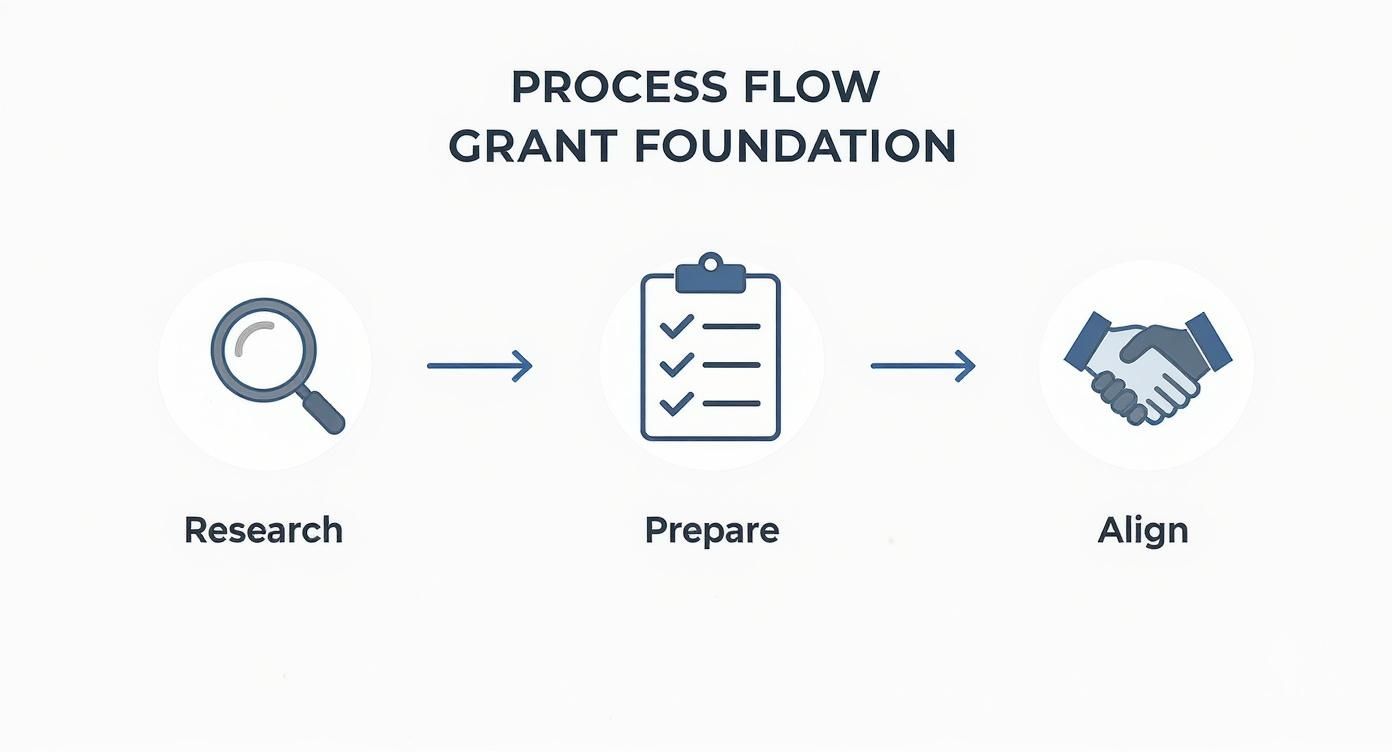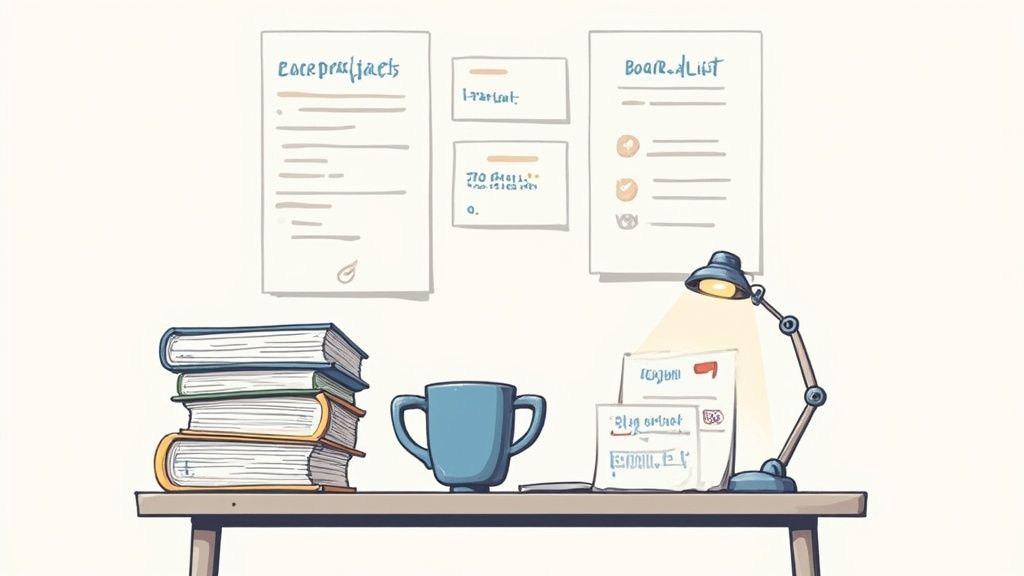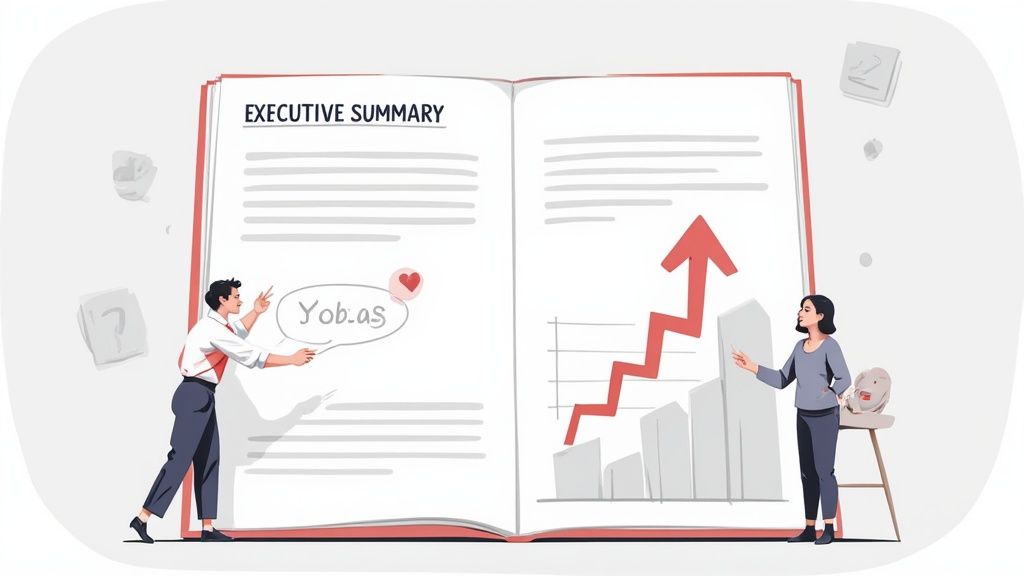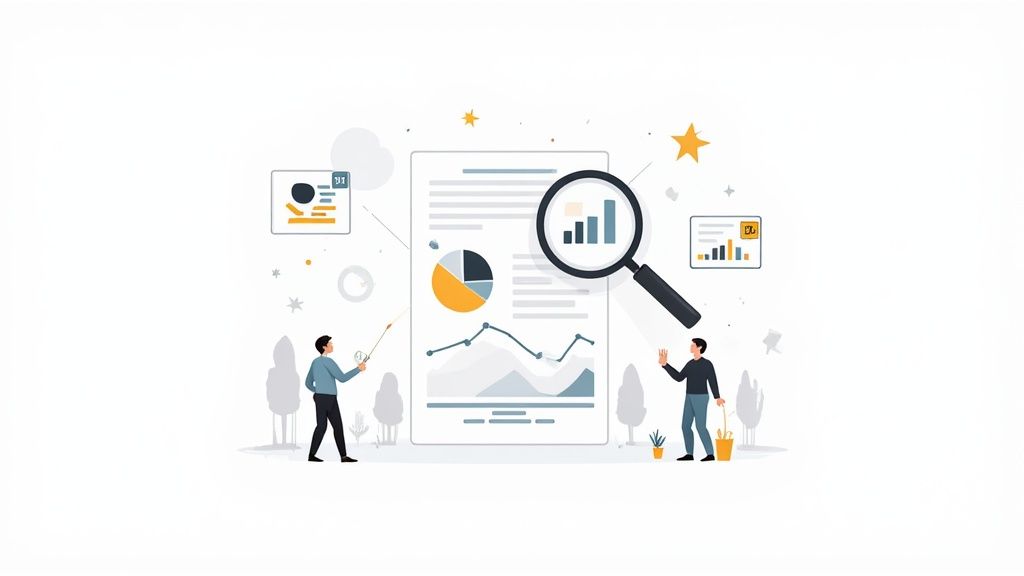how to write grants for nonprofit organizations: Win Grants
how to write grants for nonprofit organizations: Learn practical steps, sample proposals, and tips to craft persuasive grants that boost funding.

Great grant writing doesn't start with a blank page. It starts with a solid foundation. If you want to move from frantically chasing deadlines to confidently submitting winning proposals, you have to get your house in order first. This prep work is the secret sauce that turns grant seeking into a proactive, strategic, and ultimately successful part of your fundraising plan.
Build Your Grant-Ready Foundation
I've seen so many nonprofits make the same mistake: they find a grant opportunity and dive headfirst into writing. It's an understandable impulse, but it's a recipe for disaster. Halfway through, they realize they can't find their IRS determination letter, their program data is a mess, or worse—they aren't even a good fit for the funder.
A truly grant-ready organization thinks differently. They treat this as a continuous cycle, not a one-off sprint. It all begins with building a "grant writing toolkit" that's ready to deploy at a moment's notice.
Essential Documents for Your Toolkit
Before you even start looking for grants, pull together the core documents every single funder will want to see. Having these updated and in one place will save you from a world of last-minute stress.
- IRS Determination Letter: This is your non-negotiable proof of 501(c)(3) status. Keep a clean digital copy handy.
- Annual Organizational Budget: Funders need a clear, comprehensive picture of your financial reality.
- List of Board Members: Be sure to include their professional affiliations to show the depth of your community support and governance.
- Recent Financial Statements: This usually means your most recent audit or your latest Form 990.
- Key Program Outcomes: Get your data in order. You need hard numbers and compelling success stories to prove your impact.
This isn't just about ticking boxes; it's about building a compelling case for your organization before you even know who you're talking to.

Think of it this way: your documents, research, and mission alignment all feed into one another. When this foundation is strong, you stop just applying for grants and start building real partnerships with funders who are genuinely invested in your work.
Aligning Your Mission with Funder Priorities
With your toolkit ready, it's time for some smart research. I can't stress this enough: the goal isn't to find any grant, it's to find the right grant. Misalignment is probably the number one reason good proposals get rejected. A funder dedicated to conserving California's coastline isn't going to fund your after-school arts program in New York, no matter how beautifully you write the proposal.
A warm story might get someone to give you $20, but a foundation with $50,000 grants can’t give based on heart-warming stories alone. Successful grant applications focus on impact, alignment, and data.
Start by sketching out your ideal funder. What's their geographic focus? What's their typical grant size? Who have they funded in the past? If you run a local food pantry, you should be looking for foundations that specifically support hunger relief in your county. This is where tools like Fundsprout can be a huge time-saver, helping you pinpoint funders whose priorities truly reflect your own.
Vetting Opportunities and Screening Eligibility
Okay, you've found a potential match. Don't start writing yet! The final piece of your foundation is a meticulous vetting process. You need to read the application guidelines from top to bottom, paying extra close attention to the fine print on eligibility.
Look for common deal-breakers that can trip you up:
- Geographic restrictions: Is the funding limited to a specific city, state, or even a single neighborhood?
- Organizational budget size: Some funders only support organizations with budgets under $500,000, while others only look at those over $1 million.
- Years in operation: Does the foundation require applicants to have been operating for a minimum of three years?
Skipping this screening is the fastest way to waste your team's precious time and energy. By confirming you're a perfect fit before you write a single word, you ensure you're only chasing opportunities you have a real shot at winning. This discipline is what separates the nonprofits that are consistently funded from those that are just spinning their wheels.
Find the Right Funders for Your Mission
If you think grant writing is a numbers game—sending out a hundred generic proposals and hoping one sticks—I've got some bad news. It’s not. Real success comes from finding true partners who believe in your mission as deeply as you do.
This is about a targeted approach, shifting your mindset from a numbers game to a relationship-driven strategy. It’s about working smarter, not just harder, and it dramatically increases your odds of actually getting that check.
The first step is looking beyond a simple Google search. You need to identify foundations and government agencies with a proven track record of supporting work just like yours. This is where dedicated grant databases become your best friend, saving you from countless hours of going down the wrong rabbit holes.
Leverage Powerful Prospecting Tools
To build a solid list of funders who are actually a good fit, you need the right tools. Platforms like the Foundation Directory Online and Instrumentl are industry standards for a reason. They offer incredible insight into a funder’s priorities, typical grant sizes, and, most importantly, their past giving history. These databases let you slice and dice opportunities by your specific field, geographic location, and project type.
You don't always need a pricey subscription to get started, either. Many organizations find amazing opportunities by exploring free grant databases. For example, our team regularly updates a free grant database for nonprofits that can help you discover new funders without any upfront investment.
Here's a peek at what you can expect from a dedicated platform like Instrumentl. It’s all about getting a clear, organized view of your options.

A dashboard like this helps you quickly sort through the noise and prioritize the leads that are most promising for your specific programs.
Analyze Funder Giving Patterns
Once you've got a promising funder in your sights, it's time to put on your detective hat. A foundation's website tells you their stated mission, but their financial records tell you the real story of what they actually fund. The key here is the Form 990-PF, a document every private foundation is required to file with the IRS.
On this form, you'll see exactly which organizations they gave money to, the size of each grant, and sometimes a brief description of what the project was for. This information is pure gold.
Let's say a foundation’s website says it supports "youth development." But when you dig into their 990s, you see that every grant for the past three years went to sports programs. Your after-school coding camp, as amazing as it is, probably isn't the right fit. You’ve just saved yourself a ton of time.
This homework is critical because grant funding is intensely competitive. On average, the success rate for foundation and federal grants hovers around 10%. Considering it can take 15-20 hours to prepare a single foundation proposal, you can't afford to waste time on long shots. Spend your energy on opportunities where you know there's strong alignment.
Build Relationships Before You Apply
Here’s a secret the most successful grant seekers know: they don't just submit applications; they build relationships. Funders are people, and people prefer to invest in organizations they know and trust. This is the often-overlooked art of relationship-building, and it can make all the difference.
The goal is to transform your interaction from a cold transaction into a collaborative partnership. A program officer who understands your work is your best advocate when funding decisions are being made.
Reaching out doesn't have to be intimidating. It's about being professional and respectful of their time.
Here’s a simple way to get started:
- Find the right person. Look for the program officer who oversees your area of focus. Their contact info is usually on the foundation's website.
- Send a brief introductory email. Introduce your organization, explain your project in a couple of sentences, and connect it directly to their foundation's mission. Do not attach a full proposal.
- Ask for a brief call. Politely request a 15-minute chat to share a bit more and ask a few insightful questions. This shows you're serious and have done your research.
This kind of proactive outreach positions you as a thoughtful, strategic partner, not just another name in a stack of papers. You're showing them you're interested in a real partnership, and that’s the best way to set the stage for a successful proposal.
Craft a Compelling Proposal Narrative
This is where your grant proposal comes alive. The narrative is the story you tell, the part where you weave together all your research, data, and planning into a persuasive case for why your work deserves funding.
Think of it as your opportunity to connect with the grant reviewer on a human level. You need to make them feel the urgency of the problem you’re solving and see the brilliance in your solution. A truly great narrative doesn't just list facts—it paints a picture of need, action, and impact, showing the funder you’re the most credible and effective organization for the job.
This is storytelling, but with a clear purpose.
The Statement of Need: Your Hook
Every great story starts with a compelling hook. In grant writing, that's your statement of need. Your job here isn't just to say a problem exists; it's to prove it with a powerful mix of hard data and real-world stories. You're building a case that's simply impossible to ignore.
Start with the big picture, but quickly bring it down to the community you serve. Don't just make a vague claim like "many children struggle with literacy." Get specific and show the reviewer you've done your homework.
For instance, you could say: "In our county, 42% of third-graders are reading below grade level, a statistic that has profound, long-term consequences for their future success."
That number is stark, but it's just a number. To make it hit home, you need to bring it to life. Follow up your data with a short, powerful anecdote that illustrates the human cost.
You could share a brief story about a student who came to your program shy and disengaged but is now a confident reader. This blend of quantitative data and qualitative storytelling makes the problem real. It moves the issue from a statistic on a page to a challenge that demands a solution.
This one-two punch of data and story is incredibly effective. It grabs the reviewer’s attention right away and establishes a sense of urgency.
Describing Your Project with Clarity and Confidence
Once you've clearly established the why, you need to explain the how. Your project description is your plan of action, laid out so clearly that anyone can understand it. This is crucial—avoid internal jargon and acronyms like the plague. Write as if the reviewer has never heard of your organization before.
A rock-solid project description usually breaks down into three core components:
- Goals: These are the big-picture aims of your project. For a literacy program, a goal might be: "To improve literacy skills for elementary school students in our community."
- Objectives: Think of these as the specific, measurable milestones you'll hit to achieve your goals. An objective could be: "By the end of the school year, 75% of program participants will improve their reading scores by one grade level."
- Activities: These are the concrete, day-to-day actions your team will take. Examples include things like "Conduct twice-weekly, one-on-one tutoring sessions" or "Host monthly family literacy nights to engage parents."
This structure gives the funder a clear roadmap. It shows them exactly what you plan to do, how you'll do it, and what success will look like. It builds tremendous confidence that your plan is well-thought-out and, most importantly, achievable.
Keep in mind, the philanthropic world is changing. Many funders are embracing trust-based philanthropy, which means they're looking for partners they can count on to deliver results without excessive oversight. They often prefer to offer more flexible, multi-year funding to organizations with solid plans. A clear, logical project description is more critical than ever. You can read the full research on 2025 grant trends to learn more about this important shift.
Structuring Your Story From Start to Finish
The flow of your narrative is just as important as its individual parts. Your proposal needs to read like a cohesive story, with each section logically building on the one before it.
A classic, effective structure often begins with a brief introduction, like an executive summary or a Letter of Inquiry (LOI). If you’re looking for a good example of how to structure that initial outreach, our guide includes a helpful sample grant Letter of Inquiry.
From there, the story unfolds naturally. You present the problem (statement of need), introduce your solution (project description), and then detail how you'll measure success (evaluation plan). This progression makes it easy for the reviewer to follow your thinking and see the direct line between the community's need and your proposed impact.
By the time they finish reading, they shouldn't just be informed—they should feel inspired to partner with you in making a real difference.
Develop a Realistic and Persuasive Budget

If your proposal's narrative is the heart of your grant request, the budget is its backbone. It’s where the story you've told meets the hard reality of dollars and cents. A weak, vague, or unrealistic budget is one of the fastest ways to get your proposal moved to the "no" pile.
Think of it this way: your budget is the financial proof of your plan. It’s a detailed roadmap that shows a funder you’ve thought through every step and can responsibly manage their investment. Every single number should echo the activities you’ve described, creating a rock-solid link between your vision and the resources you need to bring it to life.
Breaking Down Your Project Costs
To build a budget that inspires confidence, you need to account for everything. This means getting granular with both your direct and indirect costs. If you miss key expenses, it looks like you haven’t done your homework. If you inflate them, you risk your credibility.
Direct costs are the easy ones—they are expenses tied directly and exclusively to your project. Think of these as the tangible things you need to run the program.
- Personnel: List the staff who will work on the project and the percentage of time they'll dedicate. Don’t just list a title; be specific.
- Fringe Benefits: This covers the associated costs for your staff, like taxes and insurance. It's a real expense, so don't forget it.
- Supplies: What materials will you need? Art supplies for a kids' workshop? Workbooks for an adult literacy class? List them out.
- Equipment: Do you need a new laptop or a specific piece of software to make this project happen? This is where that goes.
- Travel: Any mileage, airfare, or lodging costs required to deliver your services belong here.
Indirect costs are a bit trickier. Often called overhead, these are the shared expenses that keep your organization running but aren't tied to a single project—think rent, utilities, or the salary of your executive director. Funders all have different rules for this. Some cap it at a specific percentage (often 10-15%), while others will want a detailed explanation. Always check the guidelines first.
Justifying Every Dollar
Here’s a tip that separates the pros from the amateurs: never just list a number. You need a budget justification (sometimes called a budget narrative). This is a plain-language explanation of why you need what you’re asking for. It’s your chance to walk the reviewer through your thought process and connect every expense back to the project's goals.
For instance, instead of a line item that just says "$2,000 for Supplies," you should write something like this:
Supplies - $2,000: This line item covers the cost of 100 literacy kits for our student participants ($15/kit = $1,500) and the printing of 500 parental engagement workbooks ($1/workbook = $500). These materials are fundamental to our twice-weekly tutoring sessions and monthly family literacy events.
See the difference? You’ve removed all the guesswork. That level of detail shows the funder you’ve researched your costs and have a deep, practical understanding of what it will take to succeed.
Showing You Have Other Backers
Funders almost never want to be the only ones supporting a project. They want to see that you have other sources of income and broad community support. Why? Because it signals that your project is viable and can be sustained long after their grant money runs out.
Your budget is the perfect place to show this. Create columns that clearly lay out the full financial picture:
- Amount Requested from Funder: What you're asking for in this proposal.
- Other Secured Funding: Money you already have in the bank for this project.
- Pending Requests: Other grant applications you have out for the same work.
- In-Kind Contributions: The value of donated goods or services, like a volunteer’s time or free meeting space.
By showing other funders and partners are already invested, you change the entire conversation. You're no longer just asking for money; you're inviting them to join a collaborative effort that’s already on the path to success.
This strategy demonstrates that you’re a resourceful and well-supported organization—exactly the kind of partner funders love to work with.
Use Data to Prove Your Impact
A powerful story can capture a funder's heart, but it's the solid data that convinces their head. Your narrative makes your mission feel urgent and personal; your data makes your proposed solution undeniable.
Gone are the days when good intentions were enough to secure a grant. Today’s funders need to see proof of impact, and that proof is built on a foundation of carefully collected and clearly presented data. This isn't about burying a reviewer in spreadsheets. It’s about strategically weaving key numbers and evidence into your proposal to build an irrefutable case for your work.
Set Goals That Funders Can Get Behind
Before you can show your impact, you have to define what success actually looks like in clear, measurable terms. This is where the SMART framework becomes your best friend. It forces you to move beyond vague aspirations and create objectives that a grant reviewer can easily grasp and evaluate.
A SMART goal is:
- Specific: What, exactly, will you do? (e.g., "Provide tutoring to 50 third-grade students.")
- Measurable: How will you track progress? (e.g., "...will improve their reading scores...")
- Achievable: Is this realistic with your resources and timeline? (e.g., Do you have the tutors and space?)
- Relevant: Does this goal directly address the need you've identified and align with the funder's mission?
- Time-bound: What’s the deadline? (e.g., "...by the end of the 2025-2026 school year.")
See the difference? "We will help children read better" is a nice thought, but it’s not a goal a funder can invest in.
Now, look at this: "By June 2026, 75% of the 50 students enrolled in our after-school program will improve their reading comprehension scores by one full grade level, as measured by the district's standardized literacy assessment." That’s a goal. It’s crisp, clear, and gives a funder absolute confidence in your plan.
Your evaluation plan isn't an afterthought; it's the part of your proposal that proves your program works. It shows you are committed not just to doing good work, but to understanding and improving that work over time.
This shift toward data is reshaping the entire funding landscape. Funders now expect evidence-based proposals that show measurable outcomes. To compete, you have to integrate both hard numbers and compelling stories—community needs statistics, your past success metrics, and well-supported projections of your future impact. You can find more insights on these modern expectations in this guide to effective grant writing strategies on bradymartz.com.
A data-driven approach isn't just a trend; it's a fundamental shift in how funders assess a nonprofit's potential. To build a compelling case, you need to arm yourself with the right information.
The table below outlines the essential data points that will give your grant proposal the credibility and evidence it needs to stand out.
Essential Data Points for Your Grant Proposal
By weaving these numbers into your narrative, you transform your proposal from a simple request into a sound investment opportunity.
Build Your Evaluation and Data Collection Plan
Once your SMART goals are locked in, you need to explain how you'll measure them. Your evaluation plan should detail your Key Performance Indicators (KPIs)—the specific metrics you'll track—and the exact methods you'll use to collect the information.
A strong plan uses a mix of quantitative and qualitative data.
- Quantitative data is the "what." It's the numbers—participant counts, test scores, attendance rates.
- Qualitative data gets to the "why" and "how." These are the stories you gather from surveys, focus groups, interviews, and testimonials.
Let's go back to our literacy program example. The data collection plan might look something like this:
- Standardized Test Scores: Collect scores at the start and end of the program to measure concrete improvement.
- Tutor Session Logs: Track student attendance while also documenting specific challenges or breakthroughs.
- Parent and Teacher Surveys: Gather feedback on changes in student confidence and engagement with reading outside of the tutoring sessions.
Your proposal just needs a brief description of these methods, who’s in charge of collecting the data, and when it will happen. This level of detail shows the funder you have a real system for tracking progress and proving success. It’s a powerful signal that you’re organized, accountable, and laser-focused on delivering results.
Common Grant Writing Questions Answered

Whether you’re a seasoned grant professional or just starting out, the same questions tend to pop up time and again. Getting them answered can mean the difference between a successful application and a missed opportunity. Let's dig into some of the most common hurdles I see nonprofits face.
A classic one is, "How long should my proposal be?" The honest answer? It depends. There’s no magic number here.
The funder is your guide. A private foundation might want a quick two or three-page Letter of Inquiry (LOI) to start, whereas a big federal grant application could easily sprawl past 50 pages. Always, always stick to their page or word limits. If they don't give you any, aim for a tight 5-15 pages.
The real goal is clarity, not just hitting a certain page count. A powerful, concise proposal will always beat a long, rambling one. Show respect for the reviewer's time by getting straight to the point.
What Is the Biggest Grant Writing Mistake?
By far, the most critical mistake I see is sending out a generic, "one-size-fits-all" proposal. Reviewers spot these instantly, and it sends a clear message: you didn't do your homework on their specific mission.
A truly great proposal feels like it was written just for that one funder. This isn't as hard as it sounds. It just means you need to:
- Speak their language. If a foundation's website talks a lot about "community empowerment," you should be using that phrase in your proposal.
- Connect to their goals. Show a direct line between what your project does and what that funder wants to achieve in the world.
- Tailor your story. You need to spell out exactly how your work helps them fulfill their mission.
This customized approach shows you're a serious, thoughtful partner, not just another organization with your hand out. While it used to be a time-consuming process, new tools can make this much faster. For instance, you can learn more about how to use AI for grant writing to speed up customization without losing that personal touch.
How Should I Handle a Grant Rejection?
Let's be real—getting a "no" stinks. But it's a completely normal part of this work. Grant funding is incredibly competitive, and success rates often hover somewhere around 10-20%. So, instead of seeing rejection as a failure, you have to treat it as a lesson.
If the funder allows it, don't be afraid to reach out to the program officer. A polite email thanking them for the opportunity and asking if they’d be open to sharing some feedback can work wonders.
Finding out why your proposal wasn't a good fit is invaluable. Maybe your budget wasn't clear, or your needs statement didn't have enough compelling data. That feedback is pure gold for your next application.
Remember, grant writing is about persistence and building relationships. A rejection today doesn't close the door forever. Take the feedback, strengthen your proposal, keep in touch, and try again down the road.
Ready to transform your grant writing process from reactive to strategic? Fundsprout is an AI-powered platform designed to help you find the right funders, craft winning proposals, and manage your grants with ease. Discover perfectly matched opportunities and write compelling narratives faster than ever. Visit https://www.fundsprout.ai to see how we can help you secure the funding your mission deserves.
Try 14 days free
Get started with Fundsprout so you can focus on what really matters.
